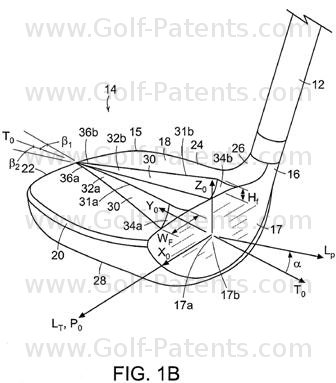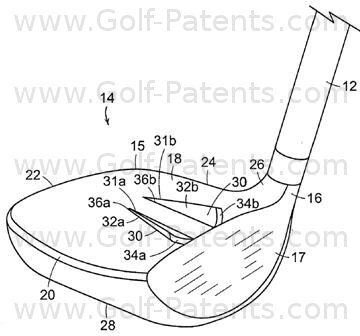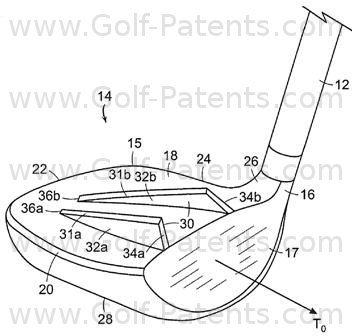Fins, Fins, Fins, Really?
Over the years I have covered a lot of golf club head designs incorporating fins and wings (see HERE, HERE, and HERE). Generally they looked like mad creations of a garage tinkerer and easy to dismiss, however now days every major club maker seems focused on aerodynamics along with complex modeling of the airflow around the club head. Therefore, when a patent application published this week directed to a finned club head it made me wonder… maybe there is something to all those old finned club heads and they were just ahead of their time (or perhaps it didn’t really matter until we started swinging gigantic club heads). Either way, the following Nike Golf patent application got my attention. The application published as US Pub. No. 20110244979 titled “Golf Club Assembly and Golf Club with Aerodynamic Features.” The application describes the invention as:
A golf club head has a body member that includes a ball striking face, a crown region, a toe region, a heel region, a sole region, a rear region and a hosel region. The body member has a drag-reduction feature that may include first and second elongated fins. The fins extend in a generally front-to-rear orientation. The fins are spaced farther apart at their forward-most ends than at their rearward-most ends. Alternatively, the drag-reduction feature may include first and second elongated indentations. The indentations extend in a generally front-to-rear orientation. The indentations are spaced farther apart at their forward-most ends than at their rearward-most ends. The drag-reduction features may be located on one or both of the crown region or the sole region. A golf club including the golf club head is also provided.








The application goes on to explain:
BACKGROUND
[0002] The distance a golf ball travels when struck by a golf club is determined in large part by club head speed at the point of impact with the golf ball. Club head speed in turn can be affected by the wind resistance or drag provided by the club head during the entirety of the swing, especially given the large club head size of a driver. The club head of a driver or a fairway wood in particular produces significant aerodynamic drag during its swing path. The drag produced by the club head leads to reduced club head speed and, therefore, reduced distance of travel of the golf ball after it has been struck.
[0003] Air flows in a direction opposite to the golf club head’s trajectory over those surfaces of the golf club head that are roughly parallel to the direction of airflow. An important factor affecting drag is the behavior of the air flow’s boundary layer. The “boundary layer” is a thin layer of air that lies very close to the surfaces of the golf club head during its motion. As the airflow moves over the surfaces, it encounters an increasing pressure. This increase in pressure is called an “adverse pressure gradient” because it causes the airflow to slow down and lose momentum. As the pressure continues to increase, the airflow continues to slow down until it reaches a speed of zero, at which point it separates from the surface. The air stream will hug the club head’s surfaces until the loss of momentum in the airflow’s boundary layer causes it to separate from the surface. The separation of the air streams from the surfaces results in a low pressure separation region behind the club head (i.e., at the trailing edge as defined relative to the direction of air flowing over the club head). This low pressure separation region creates pressure drag. The larger the separation region, the larger the pressure drag.
[0004] One way to reduce or minimize the size of the low pressure separation region is by providing a streamlined form that allows laminar flow to be maintained for as long as possible, thereby delaying or eliminating the separation of the laminar air stream from the club surface.
[0005] Reducing the drag of the club head at the point of impact (and, if possible, also prior to the moment of impact) would result in improved club head speed and increased distance of travel of the golf ball. When analyzing the swing of professional golfers, it has been noted that, although the heel/hosel area of the club head leads the swing during a significant portion of the downswing, the ball striking face leads the swing at (or immediately before) the point of impact with the golf ball. The phrase “leading the swing” is meant to describe that portion of the club head that faces the direction of swing trajectory. For purposes of discussion, the golf club and golf club head are considered to be at a 0.degree. orientation when the ball striking face is leading the swing, i.e. at the point of impact. During the final portion of the downswing, the club head is traveling at its maximum speed, which may reach approximately 65 miles per hour (mph) to over 100 mph, and in the case of some professional golfers, to as high as 140 mph. It may be desirable to provide a golf club head with reduced drag when the speed of the club head is greatest.
[0006] Club heads that have been designed to reduce the drag of the head at the point of impact, or from the point of view of the club face leading the swing, may actually increase the drag during other phases of the swing cycle, such as when the heel/hosel region of the club head is leading the downswing. Thus, additionally, it may be desirable to provide a golf club head with reduced drag when the speed of the club head is greatest, while not having an increased drag during other portions of the golf swing.
.
.
.
[0041] According to certain aspects, as shown in FIGS. 1A and B, the crown region 18 may have a drag-reduction feature 30. The drag-reduction f
eature 30 may include one or more fins 32. Drag-reduction feature 30 of FIGS. 1A and 1B is configured to channel air flowing over the crown region 18 of the club head 14 generally from the ball striking face 17 toward the rear region 22. Specifically, the drag-reduction feature 30 is configured to channel air flowing between the fins 32 from a wider region in the forward portion of the club head 14 to a narrower region in the rearward portion of the club head 14. As the air within the drag-reduction feature 30 is channeled, it is expected that its speed and energy content will increase. At the same time, it is expected that the air flowing between the fins will be oriented or aligned such that uniform flow occurs substantially in a single direction. Uniform air flow, which may be described as laminar flow, generally reduces aerodynamic drag forces (in contrast to turbulent air flow).
Could there really be something to this madness? I am betting that fins are not the new square but if I am wrong and one of these actually makes it to the market, I will be in the front of the line to try it out. The only thing that surprises me about this application is that the fins aren’t adjustable, after all it seems that golfers will buy anything that is marketed as adjustable. Can’t you just imagine one of these designs with the Tiger Woods logo on it!
Dave Dawsey – Monitoring Golf Inventions
